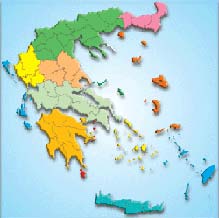
Please click on the map,
the region you want to visit |
|
|
|
|
| |
|
 |
Lefkada, Karsanika embroideries |
|
They became known from their eminent Karsaniki stitch that took its name from Karia of Lefkada, the place from where it began.
For reasons of facility and because a few people knew the
village of Karia, but many knew Lefkada, the visitors of
the island gave it its second name, Leykaditiki, with
which it is also known.
The technique of karsaniki stitch has as base the technique of skep-stitch, but also the horizontal drawing, the cross-stitch.
It is the successor of the embroideries with the said Byzantine stitch,
with which the women of Karia had already engaged themselves.
Initially the women of the region made
artworks, embroidering the feminine underwear,
the long feminine shirts and the collar of the male's
shirts. Afterwards, extending their artistic activities,
dealt with wallpaper
ablecloths, sheets, pillowcases etc. using as
material the flax that wove in local looms
and with the same material embroider on it.
An important role in the distribution of
the new technique has Maria Stayraka or
Koytsochero, who was born in Karia in 1860.
When she was young, after an accident,
she broke her hand, and the doctors mutilate
it in order to avoid a possible contamination.
With her strong will and with a big effort,
she achieved to continue the embroidery by using one
hand and to contribute to the spread of the new technique.
Later, in the 1912, with the important help of the bride of the poet Aristotelis Valaoritis, Zoe Valaoriti, the Faculty of Embroideries is founded in Karia.
Now, "Koytsochero"
teaches the art of embroidery to her students,
prompting in the creation of new drawings and
advising for imagination in the creation of their work.
Argiris Stavrakas, a crippling of war nailed in an armchair, was one of her first
students. His infirmity did not stand as an obstacle in his active pastime with
the embroidery and finally, after he learned excellently her
technique, he contributed decisively to its spread,
continuing effectively the local delivery.
Today, have remained few traditional needle-women,
mostly old women, that they continue to embroidering
at the back streets of the village. |
 |
Accommodation proposals, entertainment and shopping in Lefkada |
|
|
|